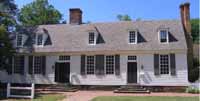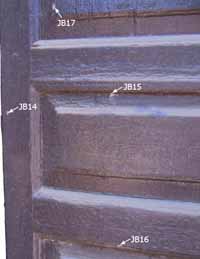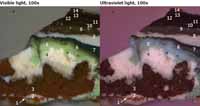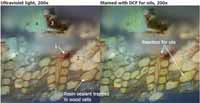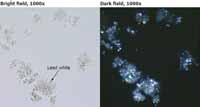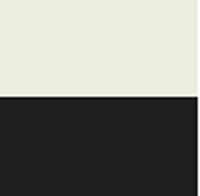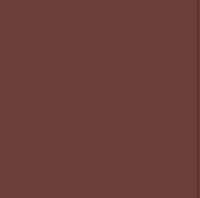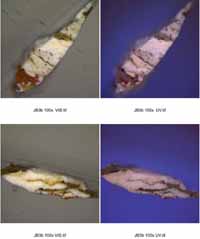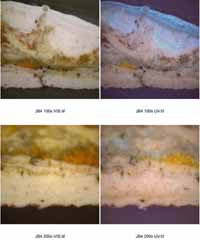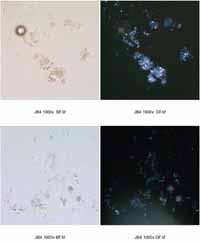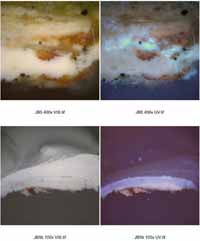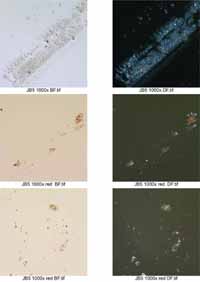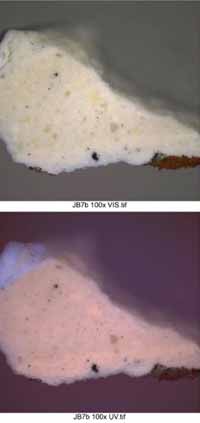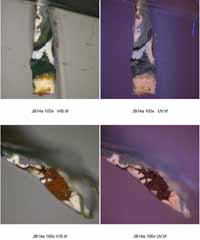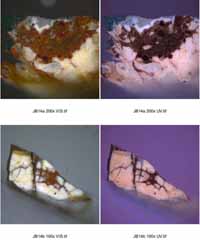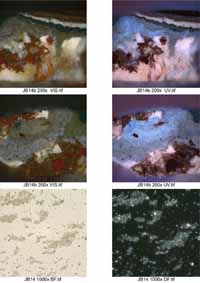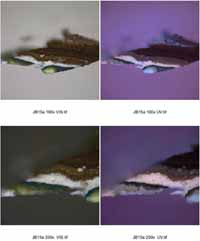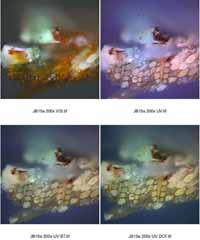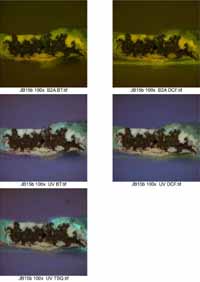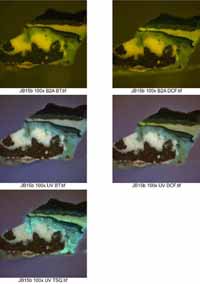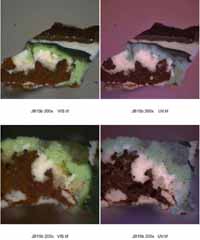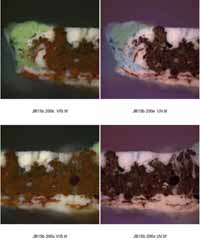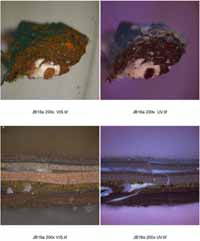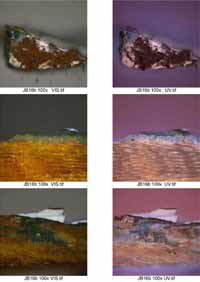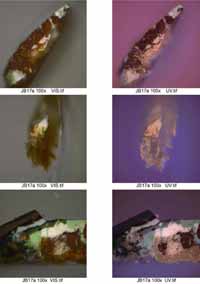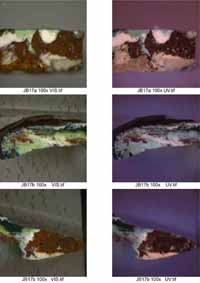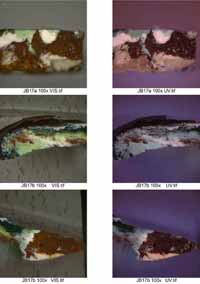Cross-Section Microscopy Analysis of Exterior Paints: John Blair House (Block 22, Building 5), Williamsburg, Virginia
Colonial Williamsburg Foundation Library
Research Report Series - 1737
Colonial Williamsburg Foundation
Library
Williamsburg, Virginia
2012
Cross-Section Microscopy Analysis of Exterior Paints
John Blair House
(Block 22, Building 5)
Williamsburg, Virginia
Table of Contents
| Purpose | 1 |
| Previous Research | 1 |
| Historical Background | 1 |
| Sampling Procedures | 2 |
| Sampling Locations | 2 |
| Results of Cross-Section Analysis | 3 |
| Results of Binding Media Analysis with Fluorochrome Stains | 9 |
| Results of Pigment Identification with Polarized Light Microscopy | 11 |
| Results of Color Measurement | 13 |
| Conclusion | 16 |
| Appendix | |
| Sampling Memorandum | 17 |
| Cross-Section Preparation Procedures | 18 |
| Binding Media Analysis Procedures | 18 |
| Pigment Identification Procedures | 18 |
| Color Measurement Procedures | 19 |
| Color Measurement Data | 20 |
| Contact Sheets of Cross-Section Photomicrographs | 22 |
Cross-Section Microscopy Analysis of Exterior Paints
| Structure: | John Blair House, Colonial Williamsburg Foundation |
|---|---|
| Requested by: | Edward A. Chappell, Director, Architectural Research Department |
| Conservator: | Natasha K. Loeblich, Architectural Paint Analyst, Architectural Research Dept. |
| Consultant: | Susan L. Buck, Ph.D., Conservator and Paint Analyst |
| Funded by: | A Fidelity Foundation Grant to Colonial Williamsburg Foundation |
| Date: | July 2007 |
Purpose
This report is an addendum to an earlier study of the finishes at the John Blair House done by Peggy Olley in October of 2004.1 In that report Olley examined samples from the transom of the western door on the front (southern) elevation and the easternmost dormer on the north side of the house. For this report the western front door was sampled and examined to see what early finish evidence survives. Additionally, pigment identification with polarized light microscopy and colorimetery was undertaken on the first two generations of paint found on the transom and door.
Previous Research
In her report Olley found the first-generation paint on the transom of the western door consisted of a red primer and a cream-colored finish coat. No dirt was found separating the red and cream-colored paints and the two layers seemed to have blended somewhat. This suggested to Olley that they were applied at the same time and that the red was indeed a primer. There was some question as to whether the transom had been reinstalled backwards after the last restoration since the molding is on the outside of the window and the putty on the inside. After further study Chappell now believes that although this is an unusual format, the transom sash is not reversed. In support of this theory Olley found one sample from the top head of the window on the easternmost dormer on the north elevation that had remnants of the red primer trapped in the wood cells. None of the dormer samples yielded a good early finish history that could be compared to that on the transom. However, the presence of fragments of the red primer on the dormer suggested that the red primer on the transom is an exterior finish and that the transom is installed properly.
Historical Background
The eastern end of the John Blair house was built between 1722-24 according to dendrochronology. Around 1737-38 an addition was added to the west end that nearly doubled the front elevation along Duke of Gloucester Street. At this time the second western doorway was added. Some changes were made to the house around 1923 when it became a sorority house for the College of William & Mary. In 1928 Colonial Williamsburg acquired the house and restored it the year after. The only surviving original elements on the exterior are the western door and transom sash on the south elevation and the easternmost dormer on the north elevation.2 The dormer may date to the first period of construction in 1720s.
Sampling Procedures
Four samples were taken with a scalpel from the western front door of the John Blair House on July 12, 2007 by the author. All the samples were collected on-site in labeled bags and each was given a unique number corresponding to its recorded sample location. The door samples were numbered fourteen through seventeen since thirteen samples were taken from the house in 2004 for a previous report. The exact sample locations are provided in the table below.
Sampling Locations
| Sample | Location |
|---|---|
| JB14 | Western front door, west leaf, center of stile along hinge edge, adjacent to center raised panel, 1" from architrave |
| JB15 | Western front door, west leaf, below upper sticking of center raised panel, 6" from left edge of panel |
| JB16 | Western front door, west leaf, upper center of sticking of lower raised panel, 7" from left edge |
| JB17 | Western front door, west leaf, bottom left edge of top raised panel, on edge of raised center, 1" up from bottom edge |
Results of Cross-section Analysis
In her report Olley found the first-generation paint on the western front door transom consisted of a red primer and a cream-colored finish coat. For her analysis, Olley used a Olympus BH-T Series II epifluorescence microscope and fiber optic light source for visible light illumination. This microscope did not have digital image capture so cross-sections were photographed on film. For this reinvestigation of the John Blair house some of samples from the transom where examined with a newer Nikon Eclipse 80i epi-fluorescence microscope with digital image capture software. Additionally, some remaining uncast material from samples JB3, JB4, JB5, and JB7 was cast for this report.
The reevaluation of the samples from the transom suggests that the red layer was, in fact, a presentation surface and not just a primer. It appears that the red paint was allowed to weather significantly and wear down. This probably caused the red paint to become chalky, which would explain why some red pigments are smeared into the cream-colored paint layer above.
The cross-section image below shows the early paint layers on the transom at high magnification. The bottom of the sample below has impressions of wood fibers that give it a wavy surface and remnants of the first-generation red paint. Above the red is the second-generation cream-colored paint. Though there is no evidence of dirt trapped between the two layers, there is evidence of a boundary between the two paints that indicates that they were not applied at the same time.
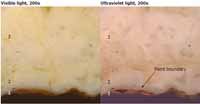 Sample JB4 from the transom sash
Sample JB4 from the transom sash
The cross-section below from the transom sash was cast by Olley and re-examined and rephotographed digitally for this report. Above the first-generation red paint are four generations of cream-colored paints. Generation six is a translucent layer with red pigments. The red pigments have a bright orange fluorescence that suggests they are particles of red lead. Generation seven is a thick, disrupted cream-colored layer with pockets of wood fibers and red paint. It is not clear why either material is present in this layer. Above generation seven are five layers of white paint. Olley applied TSQ, a biological fluorochrome stain that marks the presence of zinc (Zn2+) with a bright blue reaction color. The white paints in generations eight through twelve reacted positively for zinc, as shown by a bright blue reaction color in the ultraviolet light photomicrographs. The presence of zinc in these layers suggest they contain zinc white pigment which was not available for use in oil paint until 1835-1844, so these layers must post date that.1
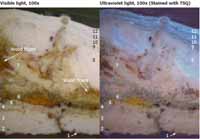 Sample JB4 from the transom sash
Sample JB4 from the transom sash
Four new samples were taken from the western front door that had not previously been sampled. Upon examination, it is clear that the wooden door has a worn and uneven surface that suggests it has been allowed to weather at periods in its life. All four of the samples from the door have disrupted stratigraphies and the wood substrate is degraded so that the wood fibers are soft and splinter easily. This suggests that the door was allowed to weather significantly disrupting the early finishes and causing the wood to decompose.
When uncast fragments of the wood substrate were examined under magnification the surface appeared saturated and glossy. The cross-section below from the western front door shows that the wood cells are filled with a resin with a range of autofluorescence colors. The different autofluorescence colors suggest that this material may actually be a mix of resins, and since the resinous material soaked into the wood fibers it was probably applied as a wood sealant.
The first generation of finish is a thin worn red paint that appears identical to that on the transom. This paint reacted weakly for oils (see page 9) but has some autofluorescence that suggests it has a resin component as well. At the left of the cross-section is a bit of the next generation which is a cream-colored paint with some yellow pigment particles. As on the transom, there is no visible grime between the cream-colored paint and the red paint, but the red paint is weathered and disrupted. It seems likely that the red paint was a presentation surface that was allowed to weather for a significant period of time before the cream-colored paint was applied. This would explain why the red layer is so thin and disrupted and why the wood substrate of the door is so weathered. There are some areas where pockets of the red pigment are embedded in the cream-colored paint layer. This could suggest that the two layers were applied at the same time and blended, but it seems more likely that the red paint is a worn presentation surface that become chalky, causing red pigments to be picked up by the cream-colored paint.
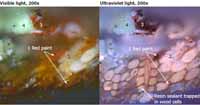 Sample JB15 from the front door
Sample JB15 from the front door
The cross-section images below show evidence of the second-generation cream-colored paint with large yellow pigment particles. The cream-colored paint flowed under and around the red paint which is still trapped to bits of wood fibers, suggesting that the red paint was allowed to weather before the creamcolored paint was applied.
The upper surface of the cream-colored paint is not flat, suggesting that this finish was also allowed to weather before the next paint layer was applied. Generation three is a thick brown paint that is coarsely ground with large clumps of pigment. This paint appears to have been applied in two coats that blended together. The brown paint also became cracked and worn before the cream-colored paint of generation four was applied. On the left side of the cross-section below is a bit of the light green paint of generation five which contains zinc white pigment (see page 10). The presence of this pigment dates this layer to after 1844.
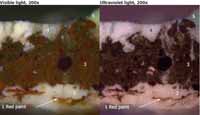 Sample JB15 from the front door
Sample JB15 from the front door
Above the light green paint of generation five is an olive green paint with gray fluorescence that comprises generation six. Generation seven is a nonfluorescent dark green paint that was applied in two coats. Generation eight consists of a cream-colored base coat and a brown finish coat. Both have a muted autofluorescence. Generations nine through eighteen are brown paints. Generations ten through thirteen have little autofluorescence and may have oil-rich binders. Generations fourteen and fifteen have a muted autofluorescence that suggests they contain a resin component. Generation sixteen and above consist of finely-ground, modern paints. Generation seventeen has a bright blue fluorescent varnish coat that would have made this a glossy surface. This varnish flowed down a crack into the brown layers below. Generations nineteen and twenty are modern black paints.
 Sample JB16 from the front door
Sample JB16 from the front door
In the cross-sections from samples JB14 and JB16 there was no evidence of the light green paint in generation five. Instead, there is a gray paint in its place which suggests the door had a multicolored decorative scheme in this period. Samples JB14 and JB16 were taken from the rails and stiles of the door which must have been gray. JB17 was taken from a raised panel which was painted green. A crosssection from sample JB15, taken at the edge of a rail and a raised panel has a bit of both the green and gray paint.
The gray paint has a sparkly bluish autofluorescence that suggest that it contains zinc white pigment like the light green paint.
Results of Binding Media Analysis with Fluorochrome Stains
Samples from the western front door were selected for staining with biological fluorochrome stains that mark out oils and zinc (Zn2+) in the layers. The cross-sections shown below from sample JB15 from the door have remnants of the first-generation red paint as well as some later layers. When the fluorochrome stain DCF was applied, there was a weak reaction for oils in the resin sealant in the wood cells and in the remnants of red paint. This is shown by a yellow reaction color that indicates the presence of unsaturated lipids. This suggests that an oil component may have been added to the resinous sealant or the first-generation red paint to increase durability. The second-generation cream-colored paint also reacted positively with a pink reaction color for saturated lipids. There was a weak reaction for unsaturated lipids in the thick brown paint of generation three, as well.
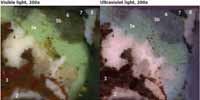 Sample JB15 from the front door
Sample JB15 from the front door
There were positive reactions for zinc (Zn2+) beginning in generation five, as shown by a bright blue reaction color in the cross-sections below. Since a feasible commercial method for delivering zinc white pigment in oil paint was not developed until 1835-1844, generation five must postdate this.
Results of Pigment Identification with Polarized Light Microscopy
Polarized light microscopy was used to identify the pigment composition of dispersed pigments from the first-generation red paint. This layer was scraped from the underside of sample JB5 from the transom. Since the red paint layer is so thin, it could not be fully isolated from the next generation of cream-colored paint. The red paint was found to be colored with iron oxide red pigment. There was a mix of fine and coarse pigments in the sample that suggests the paint was hand ground. Lead white pigments were also detected, but it is not clear whether these are present in the red layer or are contaminants from the next generation of cream-colored paint. When cross-sections of the red paint are examined in ultraviolet light, there are no clumps of lead white visible so if it is present in the red paint it is in low concentration.
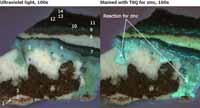 JB5 generation one dispersed pigment particles
JB5 generation one dispersed pigment particles
Polarized light microscopy was used to identify the pigment composition of dispersed pigments from the second-generation cream-colored paint on the western front door transom. This layer was isolated in sample JB4 and JB5. No colored pigment particles were found in either of the early paint layers. Instead, there was only lead white pigment, and other colorless paint fillers such as chalk. This suggests that the current slightly darkened color of the early paint is caused by the degradation and darkening of the oil binder and not by the addition of colored pigment particles.
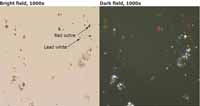 JB4 generation two dispersed pigment particles
JB4 generation two dispersed pigment particles
Polarized light microscopy was used to identify the pigment composition of dispersed pigments from the second-generation cream-colored finish on the western front door. This layer was isolated in sample JB14. The layer was found to contain mostly lead white pigment with a few large yellow ochre pigments. One red ochre pigment particle was found, but this is likely a contaminant from the red paint below this layer since no red pigments were seen in the cross-sections.
Results of Color Measurement
The first-generation red paint on the western front door leaf and transom window was too fragmented to get a large enough area to measure with the Minolta CR-241 colorimeter. Instead, a color match was found by eye at 30x magnification with a color-corrected light source by comparing color swatches to uncast portions of samples JB17 and JB16 from the door. The best commercial paint match found is Benjamin Moore 2085-10 "Arroyo Red". This paint was measured and found to have an L* value of 31.89, an a* value of +20.40, and a b* value of +12.44.
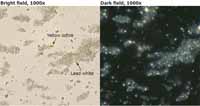 Benjamin Moore 2085-10, best commercial match to first-generation red
Benjamin Moore 2085-10, best commercial match to first-generation red
The second-generation cream-colored paint on the transom was isolated in uncast paint chips from sample JB4, JB5, and JB6 for color measurement. In total eight color measurements were taken from the uncast samples, and all the measurements were averaged. The closest measurement to the average was taken from sample JB4 and had an L* value of 75.59, an a* value of -0.31, and a b* value of +12.01, which is different from the average by a ΔE (Delta E) value of only 1.90. The best commercial match found to this measurement is Sherwin Williams DCL 033 "Clapboard" from the Carolina Lowcountry collection which has an L* value of 75.57, an a* value of -0.28, and a b* value of +11.63. This commercial paint color is different from the color of the first-generation paint in sample JB4 by a ΔE value of 0.38. Generally, ΔE values below 2 indicate a color difference that is hard for the human eye to differentiate. Thus, this commercial paint match could be used for reproducing the aged, degraded color of the firstgeneration paint applied to the west door transom.
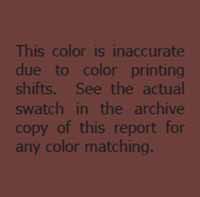 Sherwin Williams DCL 033, best commercial match to aged, second-generation transom paint
Sherwin Williams DCL 033, best commercial match to aged, second-generation transom paint
After exposing the samples to sunlight for three weeks in a window, the second-generation paint on the transom had changed by a ΔE value of 3.93, becoming less yellow. All the measurements from the lightbleached samples were averaged and the closest measurement to the average was from sample JB4. This sample had an L* value of 75.05, an a* value of -0.03, and a b* value of +9.98. The best commercial paint match found for the light-bleached, second-generation paint on the transom was Sherwin Williams 2073 "Sandbar", which has an L* value of 77.90, an a* value of -0.10, and a b* value of +10.54. This paint is different from the light-bleached paint on the transom by a ΔE value of 2.91 so it is an acceptable match for the original, light-bleached paint.
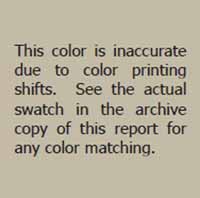 Sherwin Williams 2073, best commercial match to lightbleached, second-generation transom paint
Sherwin Williams 2073, best commercial match to lightbleached, second-generation transom paint
While Sherwin Williams 2073 "Sandbar" could be used to reproduce the darkened and degraded secondg-generation paint on the western front door transom, this would not be indicative of the appearance of the building in the eighteenth century. Since the second-generation paint was found to be colored only with lead white pigment the current color is probably due to embedded grime and darkening of the oil binder with age. It might be more accurate to repaint the trim with a color more representative of fresh lead white in linseed oil. A fresh paint composed of lead white in linseed oil would certainly have originally been much lighter, though not as bright as a modern "cool" white. A batch of lead white in linseed oil paint prepared by Susan Buck in 2004 and applied to a shellacked pine board was measured at that time to have a color value of L* 91.07, a* -1.26, b* +11.29. A good commercial paint match to this is Benjamin Moore OC 36 "Niveous" from the Off-White Colors Collection. This paint has a value of L* 89.97, a* -1.77, b* +11.11, which is different from the fresh lead white in linseed oil paint by a low ΔE value of only 1.23. Hence, this commercial paint match could be used for reproducing a fresh lead white in linseed oil paint, which is what the evidence suggests was the second-generation of paint originally applied to the western front door transom.
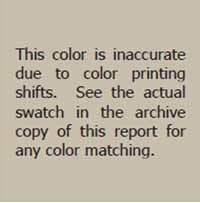 Benjamin Moore OC 36, best commercial match to fresh lead white in linseed oil
Benjamin Moore OC 36, best commercial match to fresh lead white in linseed oil
The current modern white paint on the transom was also measured. It was found to have an L* value of 91.35, an a* value of -1.95, and a b* value of +6.75, which is different from the measurement of the degraded, second-generation paint on the transom by a significant ΔE value of 16.70. (The current paint is much lighter and more blue.) Thus, the current paint is a very bad match for both the aged original paint and for fresh lead white in linseed oil paint, and is not a good interpretation of the original appearance of the transom or the rest of the woodwork.
16The second-generation cream-colored paint on the front door was also measured with the Minolta CR- 241 colorimeter. This paint has large yellow pigment particles visible in the cross-sections. When a dispersed pigment sample was examined using polarized light microscopy it was found to contain some yellow ochre pigments and lead white. This layer was isolated in uncast portions from sample JB14 and JB16 and measured. Because this layer is worn and hard to isolate only two good measurements were possible, one from each sample. The two measurements were different from each other by a ΔE value of 3.45, which is fairly close. Averaging the two color measurements yields an L* value of 73.50, an a* value of +0.58, and a b* value of +16.99. The best commercial matches to this value were then compared to the uncast portions of cream-colored paint to determined which was the best match. The closest match by eye at 30x magnification under a color-corrected light source is Benjamin Moore HC 82 "Bennington Gray" which has an L* value of 73.08, an a* value of -0.54, and a b* value of +15.47. This commercial match is different from the average by a ΔE value of 1.93, different from the measurement of JB16 by a ?E value of 1.18, and different from the measurement of JB14 by a ΔE value of 3.46. Thus it is an acceptable color match for the current aged and degraded color of the second-generation creamcolored paint.
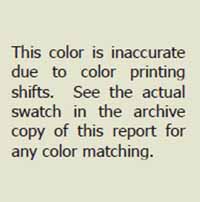 Benjamin Moore HC82, best commercial match to aged, second-generation door paint
Benjamin Moore HC82, best commercial match to aged, second-generation door paint
After exposing the samples to sunlight in a window for three weeks, the average of the measurements from the second-generation paint on the door in samples JB14 and JB16 had changed by a ΔE value of 5.25, becoming brighter and less yellow. The average of the measurements from the two light-bleached samples has an L* value of 75.68, an a* value of +0.18, and a b* value of +12.23. The best commercial paint match for the light-bleached, second generation paint on the door is Sherwin Williams 2066 "Nantucket Dune" which has an L* value of 78.76, an a* value of +0.01, and a b* value of +12.92. This paint is different from average of the light-bleached paint on the door by a ΔE value of 3.16 so it is an acceptable match.
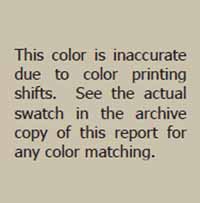 Sherwin Williams 2066, best commercial match to lightbleached, second-generation door paint
Sherwin Williams 2066, best commercial match to lightbleached, second-generation door paint
After light bleaching the second-generation paint on the transom and door were found to different from each other by a ΔE value of only 2.35 despite the fact that some yellow pigment particles were found in the second-generation paint on the door. This suggests that the yellow pigments might be a contaminant since not enough was added to significantly change the color of the paint. Thus, when the house is repainted, an identical color could be used to paint both the transom and door. Since the transom samples yielded better evidence for colorimetry, the color match generated for that element is probably more accurate and should be used preferentially.
17The third generation on the transom and door could also be used for repainting since it could be argued that this period might represent the 1770s, the era used for interpretation in the historic area. In this generation, the transom is painted with another cream-colored paint that appears identical to the secondgeneration paint. The door however, is painted with a thick brown paint in generation three. The brown paint was isolated in uncast paint chips from sample JB17 and JB16 for color measurement. In total six color measurements were taken from the uncast samples and all the measurements were averaged. The closest measurement to the average was taken from sample JB17 and had an L* value of 31.70, an a* value of 5.49, and a b* value of +7.12 which is different from the average by a ΔE (Delta E) value of only 0.95. The best commercial match found to this measurement is Sherwin Williams 6076 "Turkish Coffee" which has an L* value of 31.28, an a* value of +5.58, and a b* value of +6.82. This commercial paint color is different from the color of the first-generation paint in sample JB17 by a ΔE value of 0.52 so this is a good match for reproducing the third-generation paint applied to the west door.
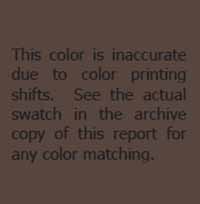 Sherwin Williams 6076, best commercial match to third-generation door paint
Sherwin Williams 6076, best commercial match to third-generation door paint
Conclusion
This examination of samples from the western front door leaf and transom sash of the John Blair House suggests that, in fact, the first-generation finish on both elements is a very worn red paint. This paint reacted weakly for oils indicating that it has an oil binder. It has some autofluorescence so it may have a resin component as well. The red paint was found to contain iron oxide red pigment which is a common and inexpensive pigment. The evidence from the paint samples suggests that the red paint was left exposed for some time. This caused the paint layer to wear down and allowed the wood surface to become degraded and fibrous. The red paint probably became chalky as the binder wore away. When the next paint finish was applied it picked up some of the loose red pigments and wood fibers. A bit of this red paint was also found in a sample from the window head of the easternmost dormer on the north elevation. This suggests that this color was applied to the whole house after it achieved its current form around 1737-38. A commercial paint match was provided for this red paint that could be used to recreate the early, eighteenth-century appearance of the house.
After the red paint there is no early finish evidence in the dormer samples. However, the second generation of finish on the transom is a cream-colored paint composed of lead white in an oil binder that is probably linseed oil, although this would need to be verified with further analytical testing. More cream-colored paints were applied to the transom in generations three through five. In generation six the transom samples have evidence of an unusual translucent layer with some red pigment particles that appear to be red lead. Generation seven on the transom is a thick and disrupted cream-colored paint that has pockets of trapped wood fibers and red paint. The transom only has twelve generations of finish while the door has fifteen. This suggests that some layers may be missing from the transom and perhaps the disruption in generation seven indicates where some intermediate layers are missing. Generation eight contains zinc white pigment so it must date to after 1844 and this layer is followed by modern white paints.
The western front door has fifteen generations of paint. The second-generation finish on the door is a cream-colored paint composed of lead white with a small amount of yellow ochre in an oil binder. This door paint was measured to be slightly more yellow than the second-generation transom paint with just enough of a color difference to be detected by the human eye. Above the second-generation creamcolored paint there is a generation of a thick, brown paint. Generation four is a cream-colored paint. Generation five dates to after 1844 and appears to have been a two-tone scheme where the rails and stiles of the door were picked out in gray and the raised panels were painted light green. Generation seven is a dark green paint, and generation eight consists of a cream-colored base coat and a brown finish coat. Generations nine through eighteen are brown paints and generations nineteen and twenty are modern black paints.
Since the historic area is interpreted to the 1770s, the second or third generation of paint on the western end of the John Blair house could be used to generate a color for repainting. The second-generation paint on the west door transom was found to be made of lead white in an oil binder. Commercial paint matches were provided for this paint before and after light bleaching. A third commercial paint match was provided that is a good match for fresh lead white in linseed oil which would be more representative of the original appearance of the second-generation paint on the transom.
The second-generation paint on the door was found to contain lead white with a small amount of yellow ochre and a commercial paint match was provided for the aged, degraded color of this paint. This paint is slightly different in color from the second-generation paint on the transom. However, after light bleaching, the second-generation door paint lightened and became closer in color to the second-generation paint on the transom which has no added yellow ochre. The commercial paint match found for the 19 light-bleached, second-generation paint on the door is very close in color to the commercial paint match for the light-bleached, second-generation paint on the transom. This suggests that the yellow ochre in the door paint might be a contaminant, not an intentional pigmentation, since barely enough was added to change the color. It might be best then to use the same color to repaint the transom and door since the colors are very close and the transom yielded better samples for colorimetry so its color matches are probably more accurate. Since there is no other early finish evidence on the house, the transom color could be extrapolated for all the trim. As mentioned before, the house could be repainted with a color that matches the aged color of the original paint, a color that matches the light-bleached original paint, or with a color that represents the appearance of fresh lead white in linseed oil.
In the third generation, the transom was again painted with a cream-colored paint and the door was painted brown. A commercial color match was provided for the brown paint so these colors could also be used for reinterpretation. Since this generation probably dates to the late eighteenth century it may be the best interpretation for this historic area.
Footnotes
Appendix
Sampling Memorandum
To: Ed Chappell
From: Natasha Loeblich
Re: Sampling of the front door at John Blair House West
Today I took four samples from the front door of John Blair House West. The architrave appeared new and didn't have good paint evidence. I numbered the samples beginning at fourteen since Peggy and you already took thirteen samples off the building. The sample locations are as follows:
| JB14 - | Western front door, west leaf, center of stile along hinge edge, adjacent to center raised panel, 1" from architrave |
| JB15 - | Western front door, west leaf, upper sticking of center raised panel, 6" from left edge of panel |
| JB16 - | Western front door, west leaf, upper center of sticking of lower raised panel, 7" from left edge |
| JB17 - | Western front door, west leaf, bottom left edge of top raised panel, on edge of raised center, 1" up from bottom edge |
Cross-section Preparation Procedures
The samples were initially examined with a stereomicroscope under low power magnification (5 to 50 times magnification) and divided as needed. When possible, a portion of each sample was kept in reserve for future analysis and a portion cast in a labeled cube of a commercial two-part polyester resin manufactured by Excel Technologies, INC. (Enfield, CT). The resin was cured under an incandescent lamp for several hours. The resin cubes were then ground on a motorized grinding wheel with 400 grit sandpaper to reveal the cross-sections. Final finishing was achieved using a Buehler Metaserv 2000 grinder polisher equipped with abrasive cloths from Micro Mesh, INC. with grits of 1500 to 12,000.
Cross-section microscopy analysis was performed using a Nikon Eclipse 80i microscope equipped with an EXFO X-Cite 120 Fluorescence Illumination System fiberoptic halogen light source. The cross-sections were examined at magnifications of 40x, 100x, 200x, and 400x using reflected visible light and a UV-2A fluorescence filter cube with a 330-380nm excitation. The cross-sections were photographed digitally using an integral Spot Flex digital camera with Spot Advanced (v. 4.6) software. The light levels of the images were adjusted in Adobe Photoshop (v. 6.0). The color on the digital images is somewhat indicative of the actual color of the paints, but cannot be used for color matching as the printing process can cause color shifts.
Under ultraviolet light many materials have characteristic autofluorescence colors that can suggest their composition. For example, most natural resin varnishes have a bright whitish autofluorescence while oil varnishes tend to be darker in ultraviolet light. Visible light microscopy can also yield valuable information. The presence of soiling layers or weathering can indicate that the finish layer existed as a presentation surface for a period of time. Since many interior finishes, such as faux graining, make use of a predictable sequence of layers, it is important to determine which layers were meant to be final presentation surfaces.
Binding Media Analysis Procedures
To better understand the composition of the paint binders, selected cross-sections were stained with biological fluorochrome stains to indicate the presence of carbohydrates, proteins, and oils in the paint binders. The stains used were ALEXA (0.1% w/v Alexafluor 488 in dimethylformamide brought to a pH of 9.0 with 0.5% borate) which marks proteins bright green, TTC (4% w/v triphenyl tetrazolium chloride in methanol) which marks carbohydrates dark red-brown, DCF (0.2% w/v 2,7 dichlorofluorescein in ethanol) which marks saturated lipids pink and unsaturated lipids yellow, and TSQ (0.2% w/v N-(6-methyl-8- quinolyl)-p-toluenesulfonamide in ethanol) which marks zinc (Zn2+) blue-white.
Pigment Identification Procedures
Samples with good accumulations of early paints identified through cross-section microscopy were scraped with a scalpel under magnification to reveal the target paint layer. A small amount of this layer was then scraped onto a glass microscope slide, dispersing the pigments. The dispersed pigments were permanently embedded under a cover slip in Cargille Meltmount (Cargille Labs., Cedar Grove, NJ). The Meltmount used has a refractive index of 1.662. The prepared slides were then examined under the microscope with transmitted visible light using a polarizing filter at a magnification of 1000x with an oil immersion objective. The morphological and optical properties of the pigment particles was observed and compared to reference pigment samples.
Color Measurement Procedures
Color measurements were made using uncast samples that were selected under magnification. An effort was made to find a clean, unweathered ares for measurement whenever possible. All color measurements were made using a Minolta Chromameter CR-241 with a measurement area of 0.3mm for uncast samples and a measurement area of 1.8mm for paint swatches. This microscope has an internal, 360° pulsed xenon arc lamp and can measure color with five color systems. The color systems used in this report are the CIE (Commission International de l'Eclairage) L*a*b* and the Munsell color system. Both systems use three values called tristimulus values to measure each color which include hue (or color), the chroma (or saturation), and lightness to darkness. In the CIE L*a*b* color system L* represents lightness from 1 to 100 with 100 being the lightest, a* represents red to green with positive numbers being more red and negative numbers more green, and b* represents yellow to blue with positive numbers being more yellow and negative numbers more blue. This system was adjusted from the CIE Yxy system developed in 1931 to better represent the human eye's sensitivity to color. In the Munsell system color measurements are given in the form of hue value/chroma with value representing lightness to darkness. Color measurement values are compared to each other using the ΔE formula which calculates the difference between to color measurements.1 The ΔE formula equals the square root of the sum of the differences in the L* value squared, the differences in the a* value squared, and the differences in the b* value squared. Generally, a ΔE value of less than two represents colors that are difficult for the human eye to differentiate.
Commercial color matches were found using swatches from Benjamin Moore, Sherwin Williams, Martin Senour, and Pittsburgh Paints. The swatches were compared to the uncast sample under magnification. The best visual matches were then measured to generate a ΔE value.
Several samples were light bleached to reduce discoloration in a hope that this would return the paints to a color that is closer to their original appearance. The target layer was exposed in uncast samples. These samples were then set in a window sill where they were exposed to sunlight for several house a day. This treatment is more successful with light color paints than with dark color paints.
John Blair House Transom
| Sample | L* | a* | b* | ΔE from average | |
|---|---|---|---|---|---|
| JB4 | 76.98 | -0.02 | 10.21 | 4.02 | |
| JB4 | 75.59 | -0.31 | 12.01 | 1.90 | best match to average |
| JB4 | 75.15 | -0.15 | 11.12 | 2.76 | |
| JB5 | 72.56 | 0.43 | 15.02 | 3.03 | |
| JB5 | 70.16 | 0.16 | 13.53 | 5.18 | |
| JB6 | 78.28 | -0.41 | 15.12 | 3.23 | |
| JB6 | 77.11 | 0.23 | 17.55 | 4.10 | |
| JB6 | 76.76 | -0.21 | 16.39 | 2.91 | |
| Standard Average | 75.32 | -0.04 | 13.87 | ||
| Average of all JB4 | 75.91 | -0.16 | 11.11 | 2.82 | |
| Average of all JB5 | 71.36 | 0.30 | 14.28 | 4.00 | |
| Average of all JB6 | 77.38 | -0.13 | 16.35 | 3.23 |
| Color Matches | ΔE from average | ΔE from best match to average | ||||
|---|---|---|---|---|---|---|
| Current paint color | 91.35 | -1.95 | 6.75 | 17.64 | 16.70 | |
| Average of door paint | 73.50 | 0.58 | 16.99 | 3.67 | 5.47 | |
| SW DCL 033 | 75.57 | -0.28 | 11.63 | 2.27 | 0.38 | |
| BM HC 80 | 76.88 | -0.04 | 13.35 | 1.64 | 1.88 | |
| SW 6149 | 76.97 | -0.94 | 13.15 | 2.01 | 1.90 | |
| PP 415-4 | 74.74 | 1.19 | 13.04 | 1.59 | 2.01 | |
| SW 2065 | 74.44 | -0.28 | 13.79 | 0.92 | 2.12 | best commercial paint match |
| SW 2058 | 74.35 | -0.03 | 13.93 | 0.98 | 2.30 | |
| SW 2822 | 77.42 | -0.54 | 13.42 | 2.20 | 2.32 | |
| PP 414-4 | 75.79 | 0.17 | 14.70 | 0.97 | 2.74 | |
| SW 2073 | 77.90 | -0.10 | 10.54 | 4.21 | 2.75 | |
| SW DMV 120 | 75.51 | -1.97 | 9.68 | 4.62 | 2.86 |
| Sample | L* | a* | b* | ΔE from average | best match to average |
|---|---|---|---|---|---|
| JB4 | 75.51 | -0.40 | 10.87 | 0.64 | |
| JB4 | 72.50 | 0.07 | 11.01 | 2.91 | |
| JB5 | 73.52 | 0.21 | 11.39 | 1.92 | |
| JB5 | 72.14 | 0.31 | 11.35 | 3.28 | |
| JB6 | 77.93 | 0.20 | 10.83 | 2.53 | |
| JB6 | 78.27 | 0.39 | 10.34 | 2.96 | |
| JB6 | 77.99 | 0.64 | 11.71 | 2.69 | |
| Standard Average | 75.41 | 0.20 | 11.07 | 2.81 | Difference after light bleaching |
| Average of all JB4 | 74.01 | -0.17 | 10.94 | 1.46 | |
| Average of all JB5 | 72.83 | 0.26 | 11.37 | 2.60 | |
| Average of all JB6 | 78.06 | 0.41 | 10.96 | 2.67 |
| Color Matches | ΔE from average | ΔE from best match to average | ||||
|---|---|---|---|---|---|---|
| Current paint color | 91.35 | -1.95 | 6.75 | 16.66 | 16.44 | |
| Average of door paint | 75.13 | -0.39 | 11.36 | 0.72 | 0.62 | |
| SW DCL 033 | 75.57 | -0.28 | 11.63 | 0.76 | 0.77 | best commercial paint match |
| BM HC 80 | 76.88 | -0.04 | 13.35 | 2.72 | 2.86 | |
| SW 6149 | 76.97 | -0.94 | 13.15 | 2.84 | 2.76 | |
| PP 415-4 | 74.74 | 1.19 | 13.04 | 2.30 | 2.80 | |
| SW DMV 120 | 75.51 | -1.97 | 9.68 | 2.58 | 1.97 | |
| SW 2073 | 77.90 | -0.10 | 10.54 | 2.57 | 2.43 |
| Sample | L* | a* | b* | ΔE from average | |
|---|---|---|---|---|---|
| JB4 | 72.92 | 0.35 | 10.45 | 2.51 | |
| JB4 | 75.05 | -0.03 | 9.98 | 0.39 | best match to average |
| JB4 | 75.85 | -0.58 | 11.08 | 1.45 | |
| JB5 | 74.60 | 0.33 | 10.40 | 0.91 | |
| JB5 | 70.81 | 0.15 | 10.51 | 4.60 | |
| JB5 | 72.09 | 0.42 | 10.24 | 3.30 | |
| JB6 | 78.54 | 0.51 | 8.64 | 3.44 | |
| JB6 | 79.36 | 0.03 | 8.96 | 4.11 | |
| JB6 | 79.13 | 0.53 | 9.28 | 3.83 | |
| Standard Average | 75.37 | 0.19 | 9.95 | 3.93 | Difference after light bleaching |
| Average of all JB4 | 74.61 | -0.09 | 10.50 | 0.98 | |
| Average of all JB5 | 72.50 | 0.30 | 10.38 | 2.91 | |
| Average of all JB6 | 79.01 | 0.36 | 8.96 | 3.77 |
| Color Matches | ΔE from average | ΔE from best match to average | ||||
|---|---|---|---|---|---|---|
| Current paint color | 91.35 | -1.95 | 6.75 | 16.43 | 16.73 | |
| Average of door paint | 75.54 | -1.13 | 10.66 | 1.50 | 1.38 | |
| SW DCL 033 | 75.57 | -0.28 | 11.63 | 1.76 | 1.75 | |
| SW DMV 120 | 75.51 | -1.97 | 9.68 | 2.18 | 2.02 | |
| SW 2073 | 77.90 | -0.10 | 10.54 | 2.57 | 2.43 | best commercial paint match |
John Blair House Door
| BM 2085-10 | 31.89 | 20.40 | 12.44 |
| Sample | L* | a* | b* |
|---|---|---|---|
| JB14 | 72.89 | 1.09 | 18.52 |
| JB16 | 74.10 | 0.06 | 15.46 |
| Standard Average | 73.50 | 0.58 | 16.99 |
| Difference between JB14 and JB16 | ΔE = | 3.45 |
| Color Matches | ΔE from average | ΔE from JB14 | ΔE from JB16 | ||||
|---|---|---|---|---|---|---|---|
| Current paint color | 12.36 | 0.73 | 0.25 | 63.39 | 63.59 | 63.23 | |
| 2nd transom paint | 75.59 | -0.31 | 12.01 | 5.47 | 3.78 | 7.19 | |
| SW DCR 003 | 74.95 | 0.58 | 15.76 | 1.91 | 1.04 | 3.48 | |
| BM HC 82 | 73.08 | -0.54 | 15.47 | 1.93 | 1.18 | 3.46 | best commercial match |
| SW 2205 | 72.28 | 1.22 | 19.29 | 2.68 | 4.40 | 0.99 | |
| SW 6143 | 71.42 | 0.36 | 18.83 | 2.78 | 4.32 | 1.67 | |
| BM HC 44 | 71.20 | 0.83 | 19.18 | 3.18 | 4.78 | 1.83 | |
| SW 2058 | 74.35 | -0.03 | 13.93 | 3.23 | 1.55 | 4.95 | |
| SW 2065 | 74.44 | -0.28 | 13.79 | 3.44 | 1.74 | 5.16 |
| Sample | L* | a* | b* | |
|---|---|---|---|---|
| JB14 | 73.93 | 0.98 | 15.47 | |
| JB16 | 74.59 | -0.52 | 15.89 | |
| Standard Average | 74.26 | 0.23 | 15.68 | |
| Difference between JB14 and JB16 | ΔE = | 1.69 | ||
| Difference before and after light bleaching | ΔE = | 1.56 |
| Color Matches | ΔE from average | ΔE from JB14 | ΔE from JB16 | ||||
|---|---|---|---|---|---|---|---|
| Current paint color | 12.36 | 0.73 | 0.25 | 63.80 | 64.18 | 63.42 | |
| 2nd transom paint | 75.05 | -0.03 | 9.98 | 5.76 | 5.95 | 5.69 | |
| SW DCR 003 | 74.95 | 0.58 | 15.76 | 0.78 | 1.16 | 1.13 | best commercial paint match |
| BM HC 82 | 73.08 | -0.54 | 15.47 | 1.42 | 1.57 | 1.74 | |
| SW 2058 | 74.35 | -0.03 | 13.93 | 1.77 | 2.03 | 1.89 | |
| PP 414-4 | 75.79 | 0.17 | 14.70 | 1.82 | 1.83 | 2.17 | |
| SW 2065 | 74.44 | -0.28 | 13.79 | 1.97 | 2.12 | 2.16 | |
| SW 2205 | 72.28 | 1.22 | 19.29 | 4.23 | 4.46 | 4.17 | |
| SW 6157 | 72.91 | -1.34 | 17.46 | 2.73 | 2.44 | 3.22 | |
| BM HC 23 | 71.80 | -0.53 | 20.10 | 5.12 | 5.05 | 5.32 |
| Sample | L* | a* | b* | |
|---|---|---|---|---|
| JB14 | 75.09 | 0.78 | 12.47 | |
| JB16 | 76.27 | -0.43 | 11.99 | |
| Standard Average | 75.68 | 0.18 | 12.23 | |
| Difference between JB14 and JB16 | ΔE = | 1.76 | ||
| Difference before and after light bleaching | ΔE = | 5.25 |
| Color Matches | ΔE from average | ΔE from JB14 | ΔE from JB16 | ||||
|---|---|---|---|---|---|---|---|
| Current paint color | 12.36 | 0.73 | 0.25 | 64.45 | 64.99 | 63.91 | |
| 2nd transom paint | 75.05 | -0.03 | 9.98 | 2.35 | 2.39 | 2.62 | |
| SW DCR 003 | 74.95 | 0.58 | 15.76 | 3.63 | 4.12 | 3.30 | |
| SW DCL 033 | 75.57 | -0.28 | 11.63 | 0.76 | 0.80 | 1.44 | |
| PP 415-4 | 74.74 | 1.19 | 13.04 | 1.60 | 2.46 | 0.78 | |
| BM HC 80 | 76.88 | -0.04 | 13.35 | 1.66 | 1.54 | 2.16 | |
| SW 6149 | 76.97 | -0.94 | 13.15 | 1.94 | 1.45 | 2.64 | |
| SW 2065 | 74.44 | -0.28 | 13.79 | 2.04 | 2.57 | 1.81 | |
| SW 2066 | 78.76 | 0.01 | 12.92 | 3.16 | 2.69 | 3.78 | best commercial match |
| BM HC 83 | 78.93 | -0.10 | 11.50 | 3.34 | 2.72 | 4.06 |
| Sample | L* | a* | b* | ΔE from average | |
|---|---|---|---|---|---|
| JB16 | 29.41 | 7.74 | 9.95 | 3.57 | |
| JB16 | 31.67 | 8.00 | 8.70 | 2.66 | |
| JB16 | 31.99 | 6.23 | 7.03 | 1.18 | |
| JB17 | 29.48 | 3.97 | 5.15 | 3.18 | |
| JB17 | 31.70 | 5.49 | 7.12 | 0.95 | best match to average |
| JB17 | 30.94 | 4.12 | 5.48 | 2.52 | |
| Standard Average | 30.87 | 5.93 | 7.24 | ||
| Color Matches |
| ΔE from average | ΔE from JB17 | ||||||
|---|---|---|---|---|---|---|---|
| Current paint color | 12.36 | 0.73 | 0.25 | 20.45 | 21.07 | ||
| SW 6076 | 31.28 | 5.58 | 6.82 | 0.68 | 0.52 | best commercial match | |
| SW 2049 | 32.73 | 4.48 | 7.69 | 2.40 | 1.55 | ||
| SW 1042 | 31.72 | 3.73 | 7.09 | 2.36 | 1.76 | ||
| BM 2114-10 | 31.07 | 4.55 | 5.55 | 2.19 | 1.94 | ||
| BM 2114-20 | 30.71 | 4.59 | 5.63 | 2.10 | 2.00 | ||
| MS W 1219 | 26.79 | 5.01 | 6.51 | 4.24 | 4.97 | ||
| SW 2021 | 30.19 | 5.04 | 5.52 | 2.05 | 2.25 | ||
| BM HC 67 | 33.39 | 4.01 | 7.93 | 3.24 | 2.39 | ||
| SW DMV 93 | 38.56 | 3.84 | 6.72 | 7.99 | 7.07 | ||
| BM HC 70 | 34.28 | 4.23 | 5.73 | 4.10 | 3.19 | ||
| SW 6069 | 30.68 | 6.83 | 9.31 | 2.27 | 2.76 | ||
| SW 2028 | 33.04 | 4.68 | 7.63 | 2.54 | 1.65 |
August 14, 2007
MemorandumTo: Edward Chappell
From: Natasha Loeblich
Re: Options for Repainting John Blair House:
| All trim: | White |
| Doors, Louvered Doors, Paneled Shutters: | Bluish black (faded) |
Issues to Consider
- -We only have evidence from the east dormer window head on the rear elevation, the west door transom, and the west door leaf. If we want a body color we will have to extrapolate it from the window trim.
- -We have no evidence for the paneled shutters or louvered doors that cover the front doors. However, the louvered doors are always kept closed and the front doors are never visible. So should we paint the louvers to match the new
- door color? Do we then paint the paneled shutters to match the louvered doors?
- -If we paint with off-white, do we use the aged, degraded color match, the light bleached color match, or a match for modern production lead white in linseed oil?
Possible Repainting Schemes
- 1.
Repaint for first generation after house achieved its current form, probably c.1737-38
We have data that the first generation on the west door transom, door leaf, and top head of the window on the east dormer on the rear elevation is an iron oxide red paint. If we extrapolate the evidence from the dormer and transom windows we could theoretically paint the whole house red-brown. We would still have to decide how to paint the shutters and louvered doors.
All trim: red-brown Door: red-brown Paneled shutters: probably red-brown Louvered doors: probably red-brown - 28
- 2.
Repaint for the second generation after house achieved its current form, possibly mid-eighteenth century
There is no evidence for the second generation on the dormer. The transom is painted with lead white in an oil binder. This could be extrapolated to paint the whole house off-white. The door leaf is nearly the same color as the transom though it has a bit of yellow ochre. When the samples were light bleached the two paints became even more similar in color. Since the ochre is present in such a small amount and hardly affects the color it could be considered a contaminant, in which case the door and trim would be painted alike.
All trim: off-white Doors: off-white Louvered doors: off-white to match doors? Paneled shutters: off-white or leave them black? - 3.
Repaint for third generation after house achieved its current form, possibly late eighteenth century
There is no evidence for the third generation on the dormer. The transom is painted with lead white in an oil binder again. This could be extrapolated to paint the whole house off-white. The door leaf is painted with a thick brown paint.
All trim: off-white Doors: brown Louvered doors: brown to match doors? Paneled shutters: brown or leave them black?
